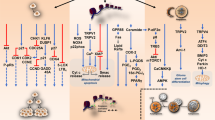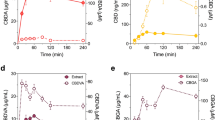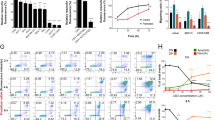Abstract
Various reports have shown that cannabinoids (the active components of marijuana and their derivatives) can reduce tumour growth and progression in animal models of cancer, in addition to their well-known palliative effects on some cancer-associated symptoms. This Opinion article discusses our current understanding of cannabinoids as antitumour agents, focusing on recent insights into the molecular mechanisms of action, including emerging resistance mechanisms and opportunities for combination therapy approaches. Such knowledge is required for the optimization of preclinical cannabinoid-based therapies and for the preliminary clinical testing that is currently underway.
This is a preview of subscription content, access via your institution
Access options
Subscribe to this journal
Receive 12 print issues and online access
$209.00 per year
only $17.42 per issue
Buy this article
- Purchase on Springer Link
- Instant access to full article PDF
Prices may be subject to local taxes which are calculated during checkout




Similar content being viewed by others
References
Gaoni, Y. & Mechoulam, R. Isolation, structure and partial synthesis of an active constituent of hashish. J. Am. Chem. Soc. 86, 1646–1647 (1964).
Pertwee, R. G. The diverse CB1 and CB2 receptor pharmacology of three plant cannabinoids: Δ9-tetrahydrocannabinol, cannabidiol and Δ9-tetrahydrocannabivarin. Br. J. Pharmacol. 153, 199–215 (2008).
Devane, W. A. et al. Isolation and structure of a brain constituent that binds to the cannabinoid receptor. Science 258, 1946–1949 (1992).
Mechoulam, R. et al. Identification of an endogenous 2-monoglyceride, present in canine gut, that binds to cannabinoid receptors. Biochem. Pharmacol. 50, 83–90 (1995).
Sugiura, T. et al. 2-Arachidonoylglycerol: a possible endogenous cannabinoid receptor ligand in brain. Biochem. Biophys. Res. Commun. 215, 89–97 (1995).
Pertwee, R. G. et al. International Union of Basic and Clinical Pharmacology. LXXIX. Cannabinoid receptors and their ligands: beyond CB1 and CB2. Pharmacol. Rev. 62, 588–631 (2010).
Matsuda, L. A., Lolait, S. J., Brownstein, M. J., Young, A. C. & Bonner, T. I. Structure of a cannabinoid receptor and functional expression of the cloned cDNA. Nature 346, 561–564 (1990).
Munro, S., Thomas, K. L. & Abu-Shaar, M. Molecular characterization of a peripheral receptor for cannabinoids. Nature 365, 61–65 (1993).
Fernandez-Ruiz, J. et al. Cannabinoid CB2 receptor: a new target for controlling neural cell survival? Trends Pharmacol. Sci. 28, 39–45 (2007).
Atwood, B. K. & Mackie, K. CB2: a cannabinoid receptor with an identity crisis. Br. J. Pharmacol. 160, 467–479 (2010).
Guzman, M. et al. A pilot clinical study of Δ9-tetrahydrocannabinol in patients with recurrent glioblastoma multiforme. Br. J. Cancer 95, 197–203 (2006).
Sarfaraz, S., Adhami, V. M., Syed, D. N., Afaq, F. & Mukhtar, H. Cannabinoids for cancer treatment: progress and promise. Cancer Res. 68, 339–342 (2008).
Katona, I. & Freund, T. F. Endocannabinoid signaling as a synaptic circuit breaker in neurological disease. Nature Med. 14, 923–930 (2008).
Pacher, P., Batkai, S. & Kunos, G. The endocannabinoid system as an emerging target of pharmacotherapy. Pharmacol. Rev. 58, 389–462 (2006).
Pertwee, R. G. Emerging strategies for exploiting cannabinoid receptor agonists as medicines. Br. J. Pharmacol. 156, 397–411 (2009).
Guzman, M. Cannabinoids: potential anticancer agents. Nature Rev. Cancer 3, 745–755 (2003).
Cudaback, E., Marrs, W., Moeller, T. & Stella, N. The expression level of CB1 and CB2 receptors determines their efficacy at inducing apoptosis in astrocytomas. PLoS ONE 5, e8702 (2010).
Hart, S., Fischer, O. M. & Ullrich, A. Cannabinoids induce cancer cell proliferation via tumor necrosis factor alpha-converting enzyme (TACE/ADAM17)-mediated transactivation of the epidermal growth factor receptor. Cancer Res. 64, 1943–1950 (2004).
McKallip, R. J., Nagarkatti, M. & Nagarkatti, P. S. Δ9-tetrahydrocannabinol enhances breast cancer growth and metastasis by suppression of the antitumor immune response. J. Immunol. 174, 3281–3289 (2005).
Zhu, L. X. et al. Δ9-tetrahydrocannabinol inhibits antitumor immunity by a CB2 receptor-mediated, cytokine-dependent pathway. J. Immunol. 165, 373–380 (2000).
Malfitano, A. M. et al. Update on the endocannabinoid system as an anticancer target. Expert Opin. Ther. Targets. 15, 297–308 (2011).
Caffarel, M. M., Sarrio, D., Palacios, J., Guzman, M. & Sanchez, C. Δ9-tetrahydrocannabinol inhibits cell cycle progression in human breast cancer cells through Cdc2 regulation. Cancer Res. 66, 6615–6621 (2006).
Sanchez, C. et al. Inhibition of glioma growth in vivo by selective activation of the CB2 cannabinoid receptor. Cancer Res. 61, 5784–5789 (2001).
Nomura, D. K. et al. Monoacylglycerol lipase regulates a fatty acid network that promotes cancer pathogenesis. Cell 140, 49–61 (2010).
Thors, L. et al. Fatty acid amide hydrolase in prostate cancer: association with disease severity and outcome, CB1 receptor expression and regulation by IL-4. PLoS ONE 5, e12275 (2010).
Zheng, D. et al. The cannabinoid receptors are required for ultraviolet-induced inflammation and skin cancer development. Cancer Res. 68, 3992–3998 (2008).
Joosten, M. et al. Leukemic predisposition of pSca-1/Cb2 transgenic mice. Exp. Hematol. 30, 142–149 (2002).
Wang, D. et al. Loss of cannabinoid receptor 1 accelerates intestinal tumor growth. Cancer Res. 68, 6468–6476 (2008).
Izzo, A. A. et al. Increased endocannabinoid levels reduce the development of precancerous lesions in the mouse colon. J. Mol. Med. (Berl.) 86, 89–98 (2008).
Blazquez, C. et al. Cannabinoids inhibit the vascular endothelial growth factor pathway in gliomas. Cancer Res. 64, 5617–5623 (2004).
Galve-Roperh, I. et al. Anti-tumoral action of cannabinoids: involvement of sustained ceramide accumulation and extracellular signal-regulated kinase activation. Nature Med. 6, 313–319 (2000).
Gomez del Pulgar, T., Velasco, G., Sanchez, C., Haro, A. & Guzman, M. De novo-synthesized ceramide is involved in cannabinoid-induced apoptosis. Biochem. J. 363, 183–188 (2002).
Carracedo, A. et al. The stress-regulated protein p8 mediates cannabinoid-induced apoptosis of tumor cells. Cancer Cell 9, 301–312 (2006).
Encinar, J. A. et al. Human p8 is a HMG-I/Y-like protein with DNA binding activity enhanced by phosphorylation. J. Biol. Chem. 276, 2742–2751 (2001).
Schroder, M. & Kaufman, R. J. The mammalian unfolded protein response. Annu. Rev. Biochem. 74, 739–789 (2005).
Verfaillie, T., Salazar, M., Velasco, G. & Agostinis, P. Linking ER stress to autophagy: potential implications for cancer therapy. Int. J. Cell Biol. 2010, 930509 (2010).
Mizushima, N., Levine, B., Cuervo, A. M. & Klionsky, D. J. Autophagy fights disease through cellular self-digestion. Nature 451, 1069–1075 (2008).
Eisenberg-Lerner, A., Bialik, S., Simon, H. U. & Kimchi, A. Life and death partners: apoptosis, autophagy and the cross-talk between them. Cell Death Differ. 16, 966–975 (2009).
Salazar, M. et al. Cannabinoid action induces autophagy-mediated cell death through stimulation of ER stress in human glioma cells. J. Clin. Invest. 119, 1359–1372 (2009).
Vara, D. et al. Anti-tumoral action of cannabinoids on hepatocellular carcinoma: role of AMPK-dependent activation of autophagy. Cell Death Differ. 18, 1099–1111 (2011).
Carracedo, A. et al. Cannabinoids induce apoptosis of pancreatic tumor cells via endoplasmic reticulum stress-related genes. Cancer Res. 66, 6748–6755 (2006).
Blazquez, C. et al. Cannabinoid receptors as novel targets for the treatment of melanoma. FASEB J. 20, 2633–2635 (2006).
Sarfaraz, S., Afaq, F., Adhami, V. M., Malik, A. & Mukhtar, H. Cannabinoid receptor agonist-induced apoptosis of human prostate cancer cells LNCaP proceeds through sustained activation of ERK1/2 leading to G1 cell cycle arrest. J. Biol. Chem. 281, 39480–39491 (2006).
Guindon, J. & Hohmann, A. G. The endocannabinoid system and cancer: therapeutic implication. Br. J. Pharmacol. 163, 1447–1463 (2011).
Ligresti, A. et al. Antitumor activity of plant cannabinoids with emphasis on the effect of cannabidiol on human breast carcinoma. J. Pharmacol. Exp. Ther. 318, 1375–1387 (2006).
Massi, P. et al. 5-Lipoxygenase and anandamide hydrolase (FAAH) mediate the antitumor activity of cannabidiol, a non-psychoactive cannabinoid. J. Neurochem. 104, 1091–1100 (2008).
Shrivastava, A., Kuzontkoski, P. M., Groopman, J. E. & Prasad, A. Cannabidiol induces programmed cell death in breast cancer cells by coordinating the cross-talk between apoptosis and autophagy. Mol. Cancer Ther. 10, 1161–1172 (2011).
Massi, P. et al. The non-psychoactive cannabidiol triggers caspase activation and oxidative stress in human glioma cells. Cel. Mol. Life Sci. 63, 2057–2066 (2006).
Casanova, M. L. et al. Inhibition of skin tumor growth and angiogenesis in vivo by activation of cannabinoid receptors. J. Clin. Invest. 111, 43–50 (2003).
Blazquez, C. et al. Inhibition of tumor angiogenesis by cannabinoids. FASEB J. 17, 529–531 (2003).
Portella, G. et al. Inhibitory effects of cannabinoid CB1 receptor stimulation on tumor growth and metastatic spreading: actions on signals involved in angiogenesis and metastasis. FASEB J. 17, 1771–1773 (2003).
Pisanti, S. et al. Antiangiogenic activity of the endocannabinoid anandamide: correlation to its tumor-suppressor efficacy. J. Cell Physiol. 211, 495–503 (2007).
Blazquez, C. et al. Cannabinoids inhibit glioma cell invasion by down-regulating matrix metalloproteinase-2 expression. Cancer Res. 68, 1945–1952 (2008).
Grimaldi, C. et al. Anandamide inhibits adhesion and migration of breast cancer cells. Exp. Cell Res. 312, 363–373 (2006).
Qamri, Z. et al. Synthetic cannabinoid receptor agonists inhibit tumor growth and metastasis of breast cancer. Mol. Cancer Ther. 8, 3117–3129 (2009).
Preet, A., Ganju, R. K. & Groopman, J. E. Δ9-tetrahydrocannabinol inhibits epithelial growth factor-induced lung cancer cell migration in vitro as well as its growth and metastasis in vivo. Oncogene 27, 339–346 (2008).
Ramer, R. & Hinz, B. Inhibition of cancer cell invasion by cannabinoids via increased expression of tissue inhibitor of matrix metalloproteinases-1. J. Natl. Cancer Inst. 100, 59–69 (2008).
McAllister, S. D., Christian, R. T., Horowitz, M. P., Garcia, A. & Desprez, P. Y. Cannabidiol as a novel inhibitor of Id-1 gene expression in aggressive breast cancer cells. Mol. Cancer Ther. 6, 2921–2927 (2007).
McAllister, S. D. et al. Pathways mediating the effects of cannabidiol on the reduction of breast cancer cell proliferation, invasion, and metastasis. Breast Cancer Res. Treat. 129, 37–47 (2011).
Galve-Roperh, I., Aguado, T., Palazuelos, J. & Guzman, M. Mechanisms of control of neuron survival by the endocannabinoid system. Curr. Pharm. Des. 14, 2279–2288 (2008).
Chan, P. C., Sills, R. C., Braun, A. G., Haseman, J. K. & Bucher, J. R. Toxicity and carcinogenicity of Δ9-tetrahydrocannabinol in Fischer rats and B6C3F1 mice. Fundam. Appl. Toxicol. 30, 109–117 (1996).
Lombard, C., Nagarkatti, M. & Nagarkatti, P. CB2 cannabinoid receptor agonist, JWH-015, triggers apoptosis in immune cells: potential role for CB2-selective ligands as immunosuppressive agents. Clin. Immunol. 122, 259–270 (2007).
Rieder, S. A., Chauhan, A., Singh, U., Nagarkatti, M. & Nagarkatti, P. Cannabinoid-induced apoptosis in immune cells as a pathway to immunosuppression. Immunobiology 215, 598–605 (2010).
Lorente, M. et al. Stimulation of the midkine/ALK axis renders glioma cells resistant to cannabinoid antitumoral action. Cell Death Differ. 18, 959–973 (2011).
Newton, C. A., Chou, P. J., Perkins, I. & Klein, T. W. CB1 and CB2 cannabinoid receptors mediate different aspects of Δ9-tetrahydrocannabinol (THC)-induced T helper cell shift following immune activation by Legionella pneumophila infection. J. Neuroimmune Pharmacol. 4, 92–102 (2009).
Lu, T., Newton, C., Perkins, I., Friedman, H. & Klein, T. W. Cannabinoid treatment suppresses the T-helper cell-polarizing function of mouse dendritic cells stimulated with Legionella pneumophila infection. J. Pharmacol. Exp. Ther. 319, 269–276 (2006).
Steffens, S. et al. Low dose oral cannabinoid therapy reduces progression of atherosclerosis in mice. Nature 434, 782–786 (2005).
Hegde, V. L., Nagarkatti, M. & Nagarkatti, P. S. Cannabinoid receptor activation leads to massive mobilization of myeloid-derived suppressor cells with potent immunosuppressive properties. Eur. J. Immunol. 40, 3358–3371 (2010).
Burstein, S. H. & Zurier, R. B. Cannabinoids, endocannabinoids, and related analogs in inflammation. AAPS J. 11, 109–119 (2009).
Liu, W. M., Fowler, D. W. & Dalgleish, A. G. Cannabis-derived substances in cancer therapy--an emerging anti-inflammatory role for the cannabinoids. Curr. Clin. Pharmacol. 5, 281–287 (2010).
Hudson, B. D., Hebert, T. E. & Kelly, M. E. Ligand- and heterodimer-directed signaling of the CB1 cannabinoid receptor. Mol. Pharmacol. 77, 1–9 (2010).
Dainese, E., Oddi, S. & Maccarrone, M. Interaction of endocannabinoid receptors with biological membranes. Curr. Med. Chem. 17, 1487–1499 (2010).
Smith, T. H., Sim-Selley, L. J. & Selley, D. E. Cannabinoid CB1 receptor-interacting proteins: novel targets for central nervous system drug discovery? Br. J. Pharmacol. 160, 454–466 (2010).
Mirkin, B. L. et al. Identification of midkine as a mediator for intercellular transfer of drug resistance. Oncogene 24, 4965–4974 (2005).
Kadomatsu, K. The midkine family in cancer, inflammation and neural development. Nagoya J. Med. Sci. 67, 71–82 (2005).
Palmer, R. H., Vernersson, E., Grabbe, C. & Hallberg, B. Anaplastic lymphoma kinase: signalling in development and disease. Biochem. J. 420, 345–361 (2009).
de Bono, J. S. & Ashworth, A. Translating cancer research into targeted therapeutics. Nature 467, 543–549 (2010).
Grande, E., Bolos, M. V. & Arriola, E. Targeting oncogenic ALK: a promising strategy for cancer treatment. Mol. Cancer Ther. 10, 569–579 (2011).
Lorente, M. et al. Amphiregulin is a factor for resistance of glioma cells to cannabinoid-induced apoptosis. Glia 57, 1374–1385 (2009).
Torres, S. et al. A combined preclinical therapy of cannabinoids and temozolomide against glioma. Mol. Cancer Ther. 10, 90–103 (2011).
Donadelli, M. et al. Gemcitabine/cannabinoid combination triggers autophagy in pancreatic cancer cells through a ROS-mediated mechanism. Cell Death Dis. 2, e152 (2011).
Miyato, H. et al. Pharmacological synergism between cannabinoids and paclitaxel in gastric cancer cell lines. J. Surg. Res. 155, 40–47 (2009).
Gustafsson, S. B., Lindgren, T., Jonsson, M. & Jacobsson, S. O. Cannabinoid receptor-independent cytotoxic effects of cannabinoids in human colorectal carcinoma cells: synergism with 5-fluorouracil. Cancer Chemother. Pharmacol. 63, 691–701 (2009).
Marcu, J. P. et al. Cannabidiol enhances the inhibitory effects of Δ9-tetrahydrocannabinol on human glioblastoma cell proliferation and survival. Mol. Cancer Ther. 9, 180–189 (2010).
Bifulco, M. et al. Control by the endogenous cannabinoid system of ras oncogene-dependent tumor growth. FASEB J. 15, 2745–2747 (2001).
Herrera, B. et al. The CB2 cannabinoid receptor signals apoptosis via ceramide-dependent activation of the mitochondrial intrinsic pathway. Exp. Cell Res. 312, 2121–2131 (2006).
Du, K., Herzig, S., Kulkarni, R. N. & Montminy, M. TRB3: a tribbles homolog that inhibits Akt/PKB activation by insulin in liver. Science 300, 1574–1577 (2003).
Ellert-Miklaszewska, A., Kaminska, B. & Konarska, L. Cannabinoids down-regulate PI3K/Akt and Erk signalling pathways and activate proapoptotic function of Bad protein. Cell Signal. 17, 25–37 (2005).
Caffarel, M. M. et al. JunD is involved in the antiproliferative effect of Δ9-tetrahydrocannabinol on human breast cancer cells. Oncogene 27, 5033–5044 (2008).
Lonardi, S., Tosoni, A. & Brandes, A. A. Adjuvant chemotherapy in the treatment of high grade gliomas. Cancer Treat. Rev. 31, 79–89 (2005).
Nieder, C., Adam, M., Molls, M. & Grosu, A. L. Therapeutic options for recurrent high-grade glioma in adult patients: recent advances. Crit. Rev. Oncol. Hematol. 60, 181–193 (2006).
Purow, B. & Schiff, D. Advances in the genetics of glioblastoma: are we reaching critical mass? Nature Rev. Neurol. 5, 419–426 (2009).
Stupp, R. et al. Radiotherapy plus concomitant and adjuvant temozolomide for glioblastoma. N. Engl. J. Med. 352, 987–996 (2005).
Caffarel, M. M. et al. Cannabinoids reduce ErbB2-driven breast cancer progression through Akt inhibition. Mol. Cancer 9, 196 (2010).
Oesch, S. et al. Cannabinoid receptor 1 is a potential drug target for treatment of translocation-positive rhabdomyosarcoma. Mol. Cancer Ther. 8, 1838–1845 (2009).
Gustafsson, K., Christensson, B., Sander, B. & Flygare, J. Cannabinoid receptor-mediated apoptosis induced by R(+)-methanandamide and Win55,212-2 is associated with ceramide accumulation and p38 activation in mantle cell lymphoma. Mol. Pharmacol. 70, 1612–1620 (2006).
McKallip, R. J. et al. Targeting CB2 cannabinoid receptors as a novel therapy to treat malignant lymphoblastic disease. Blood 100, 627–634 (2002).
Jia, W. et al. Δ9-tetrahydrocannabinol-induced apoptosis in Jurkat leukemia T cells is regulated by translocation of Bad to mitochondria. Mol. Cancer Res. 4, 549–562 (2006).
Mimeault, M., Pommery, N., Wattez, N., Bailly, C. & Henichart, J. P. Anti-proliferative and apoptotic effects of anandamide in human prostatic cancer cell lines: implication of epidermal growth factor receptor down-regulation and ceramide production. Prostate 56, 1–12 (2003).
Olea-Herrero, N., Vara, D., Malagarie-Cazenave, S. & Diaz-Laviada, I. Inhibition of human tumour prostate PC-3 cell growth by cannabinoids R(+)-Methanandamide and JWH-015: involvement of CB2 . Br. J. Cancer 101, 940–950 (2009).
Acknowledgements
This work was supported by grants from the Spanish Ministry of Science and Innovation (MICINN) (PS09/01401, FR2009-0052 and IT2009-0053 to G.V.; and PI11/00295 to C.S.), Comunidad de Madrid (S2011/BMD-2308 and 950344 to M.G.), GW Pharmaceuticals (to G.V., C.S. and M.G.) and Schering-Plough (to G.V.).
Author information
Authors and Affiliations
Corresponding author
Ethics declarations
Competing interests
G.V., C.S. and M.G. declare that GW Pharmaceuticals and Schering-Plough funded part of the research of their laboratory. Likewise, part of the data obtained by the authors in relation to the antitumour action of cannabinoids is included in three patent applications presented by GW Pharmaceuticals.
Supplementary information
Supplementary Table S1
Cannabinoid activity in animal models of cancer (PDF 213 kb)
Related links
Rights and permissions
About this article
Cite this article
Velasco, G., Sánchez, C. & Guzmán, M. Towards the use of cannabinoids as antitumour agents. Nat Rev Cancer 12, 436–444 (2012). https://doi.org/10.1038/nrc3247
Published:
Issue Date:
DOI: https://doi.org/10.1038/nrc3247
This article is cited by
-
Therapeutic and Supportive Effects of Cannabinoids in Patients with Brain Tumors (CBD Oil and Cannabis)
Current Treatment Options in Oncology (2023)
-
Cannabinoids induce functional Tregs by promoting tolerogenic DCs via autophagy and metabolic reprograming
Mucosal Immunology (2022)
-
New AKT-dependent mechanisms of anti-COVID-19 action of high-CBD Cannabis sativa extracts
Cell Death Discovery (2022)
-
Receptor-targeted nanoparticles modulate cannabinoid anticancer activity through delayed cell internalization
Scientific Reports (2022)
-
A narrative review of the ethnomedicinal usage of Cannabis sativa Linnaeus as traditional phytomedicine by folk medicine practitioners of Bangladesh
Journal of Cannabis Research (2021)



